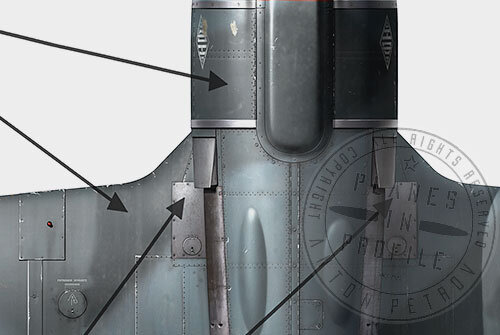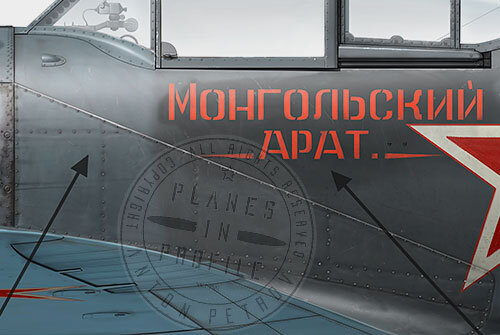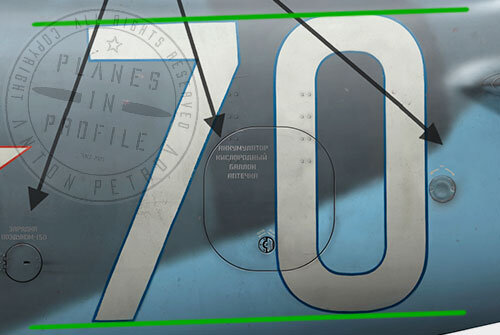“Mongolskiy Arat” White-70
Lavochkin, La-5FN
2-nd Squadron (MONGOLSKIY ARAT squadron), 2-nd GIAP (Orshanskiy), 322-nd IAD, 2-nd IAK, 3-rd Belorussian Front. 26th July, 1944. circa Vilnius, Lithuania.
It is unknown which particular pilot(s) of the 2-nd squadron flew the ‘White-70’.
The Mongolian People’s Republic (MPR) made major contributions to the Soviet war effort by donating tens of thousands of horses, livestock, items of clothing and other supplies to the Red Army, as well as donating millions of tughriks (Mongolian currency)towards the building of the tank brigade called ‘Revolutionary Mongolia’ and a fighter squadron called ‘Mongolskiy Arat’. The airplanes of this fighter squadron had the words ‘Mongolskiy Arat’ painted on their fuselages and were gifted to the 2nd squadron of the 2nd GIAP of the VVS - The squadron which became known as the ‘Mongolskiy Arat’ squadron. The first gifting ceremony took place on the 25th of September 1943 on the Vyazovaya airfield in the Smolensk region [1]. This was the first batch of airplanes gifted to the 2nd GIAP by the MPR and it consisted of 12 brand new Lavochkin La-5F fighters. These planes most likely included ‘White-11’. 'White-70’ on the other hand, was not a part of this first batch, but a part of the second batch of airplanes gifted by the MPR in May 1944. This second batch might have consisted of about 13 La-5FN airplanes (as seen in the photos linked at the bottom of the page). Apart from the photos, the evidence for the second batch of planes can be found in a book by A. Semenov (Commander of the 3rd GIAD) called ’The Mongolskiy Arat Squadron’ in which he writes that in the end of April 1944, to commemorate 23 years of People’s Revolution in Mongolia, the MPR decided to make another contribution to the Soviet war effort and among their pledges one of them read:
‘By 1st of May 1944, transfer two million tugriks into the aid fund to replenish the armaments of the 'Revolutionary Mongolia’ tank brigade and the ‘Mongolskiy Arat’ air squadron’.
On the 20th of April marshal Choybalsan sent an official telegram to Stalin asking him to accept 2 million tugriks from the Mongolian people by the International Worker’s day of 1 May, to be used to replenish the armaments of the ‘Revolutionary Mongolia’ tank brigade and the “Mongolskiy Arat’ air squadron, and towards their maintenance. Furthermore, in a letter dated 20th July the pilots of the 2nd GIAP wrote a letter to the head of the Mongolian People’s Republic in which they wrote:
‘ Having received new combat aircraft in May, bearing the name of the Mongolian people as before, we entered into battle’.
This second batch of airplanes was quite timely, because it happened not long before the start of the summer offensive to take Belorussia back from the Germans, a hugely successful Soviet campaign called Operation Bagration. As part of the preparations for the offensive, in June 1944 the 2GIAP was included into the 2nd Aviation Fighter Corps, becoming part of the 3rd Belorussian Front, and was relocated to the Novo-Myshkovo airfield in the Vitebsk region. On the 22nd of June, the start of the summer offensive, the pilots of the 2nd GIAP were lined up for the reading of the battle orders. By this time the 2nd Guards Regiment (GIAP) consisted of 41 pilots and 44 airplanes, 41 of which were La-5 airplanes [1] including the new La-5FNs of the 'Mongolskiy Arat’ squadron, which ‘White-70’ was one of.
In the first days of the offensive, the 2nd GIAP was tasked with escorting Pe-2 bombers. The bombers flew in large formations consisting of 6-8 sets of 9 planes (49-72 bombers) and the commanders of the 2nd GIAP devised special tactics to help protect such large quantities of bombers. Each of the squadrons of the 2nd GIAP escorted one regiment of bombers. The planes of the ‘Mongolskiy Arat’ squadron escorted the bombers of the 125-th Guards Bomber Avia-regiment (GBAP). While escorting the bombers, the pilots of the 2nd GIAP engaged in six air battles with the enemy. On the 23rd of June P. Marchenko and M.Ryabtsov each shot down a Me-109G. During the whole Vitebsk-Orsha offensive the pilots of the 2nd squadron prevented any enemy fighters from getting close enough to attack the bombers. The aviators of the 4th Bomber Division and the commanders of their regiments thanked the pilots of the 2nd GIAP on many occasions. On one such occasion a commander of one of the bomber regiments said the following:
‘ When we flew on missions accompanied by planes with the inscription "Mongolian Arat", I involuntarily recalled the battles over the Khalkhin-Gol steppes in 1939. Then Soviet pilots, and not only pilots, side by side with Mongolian friends - fought against the Japanese invaders and always rescued each other. A helping shoulder in combat is a big deal. And now, personally, I and my comrades feel the warmth of hearts and support of our Mongolian friends. We feel great strength. This is the power of friendship and brotherhood.’
Many pilots of the 2nd GIAP armed their planes with 50-100 kg bombs for their escort missions and dropped them on the enemy, as the bombers did. During the whole Vitebsk-Orsha operation, the pilots of the 2nd GIAP dropped 8900 kgs worth of bombs, carried out 38 group attacks, performed 184 sorties to cover 37 groups consisting of 9 Pe-2 bombers in each.
On the 26th of June 1944, the city of Vitebsk, and on the next day, the town of Orsha were liberated from the Nazi invaders. The Soviet forces continued to push the Germans back and on the 13th of July they liberated the capital of Lithuania (Vilnius). On the 19th of July, when the regiment was based 6 km south-west of Vilnius on a make-shift airfield (this is where the photos used as reference might have been taken), the regiment was notified that by the order of the Supreme High Command, for distinguishing itself in the battles for the city and the operatively important railway junction of Orsha, the 2nd GIAP was awarded the honorary title of ‘Orshanskiy’!
The overall Operation Bagration ended in the end of August 1944 with a crushing victory for the Soviets. During the whole operation, the pilots of the 2nd GIAP shot down 18 enemy planes and destroyed numerous enemy equipment and personnel. But it wasn’t without its losses. One of the pilots of the 2nd squadron, A. Dyuldin, who was shot down on the 15th of August, aimed his damaged and burning ’Mongolskiy Arat’ fighter into a column of German panzers and trucks. The hero perished in the crash, but was able to stop the column of enemy armour.
After the Belorussian offensive, the ‘Mongolskiy Arat’ Squadron went on to participate in the liberation of Ukraine and eventually in the storming of Berlin itself.
Did the Hero of the Soviet Union A.I.Mayorov fly this plane?
Having described some of the history of the ‘Mongolskiy Arat’ squadron from around the time when the photos used as reference for ‘White-70’ were taken, we should turn to the question of whether the Hero of the Soviet Union, Captain Alexandr Ivanovich Mayorov flew the 'White-70’ in battle or not. The reason being is because all the photos we have of ‘White-70’ show it with Mayorov posing on top of it and many presume that this was Mayorov’s airplane. Based on what we know however, it is unlikely that Mayorov flew this plane, despite of what the photos seem to suggest. The reason it’s unlikely is because Mayorov was a part of the 3rd squadron, not the 2nd. In fact Mayorov was the commander of the 3rd squadron at that time. In other words- he wasn’t a part of the ‘Mongolskiy Arat’ squadron which implies that he must have simply posed for the photos with the White-70, but didn’t actually fly it in battle.
In June 1944 the 1st Guards Squadron of the 2nd GIAP was commanded by Captain Boris Slavgorodsky, the 2nd Squadron "Mongolian Arat" was commanded by Captain Nikolai Zenkovich, the 3rd Squadron was commanded by Captain Alexander Mayorov [1]
NOTEWORTHY VISUAL CHARACTERISTICS
Noteworthy Visual Characteristics
1. Note the light colour at the base of the propeller blades. Even though in the reference it looks like it might be over-sprayed with the same colour as the spinner, I believe that it is more likely that this is simply bare metal showing through, since exposed metal at the base of the propeller blades can also be seen on other planes.
2. Note the peeled off paint patches on the engine cowling. This might have been due to the fresh paint being pulled off during the handling of the freshly painted engine cowling. This assumption is based on the evenly rectangular shapes of the paint chips and the knowledge that these planes were built quite hastily during the war , meaning that the paint possibly might not have had enough time to dry before the planes or their parts were handled or transported.
3. The metal cowl bands are unpainted.
4. Note the strange dark areas on the nose/engine cowling of the plane and behind the 'Mongolskiy Arat’ slogan on both sides of the plane. These seem to be present on all photographs. These might be areas which were wiped with a wet cloth to clean them up for the photo-session. But it’s also possible that these were patches of darker paint (black?) which were lightly sprayed in these areas to make the red of the engine cowling and the slogan stand out more by creating more contrast. The former theory seems to be more realistic/plausible than the latter in my opinion.
5. Note the shape of the side panel is that of the early type La-5FN
6. The technical markings on ‘White-70’ appear to be quite dark. They are barely visible in the black and white photos, but they seem to be present. It is possible that they might have been applied lightly, so the ‘white’ is transparent and looks dark. Or maybe they were painted a different colour.
7. Note that the AMT-11(light blue) colour covers some of the rudder, which is a slight deviation from the standard paint scheme instruction template introduced by NKAP in 1943
8. The symbol representing the FN model of La-5, a rhombus with the Cyrillic letters F and N inside it. These letters have to do with the improved engine which was given a designation M-82FN (or ASh-82FN). The letter ‘F’ is derived from the word ‘Forsirovanniy’ which means forced/boosted and refers to an improved supercharger (Same as in the La-5F ’s engine), and the letter ‘N’ is derived from ‘Neposredstvenniy’ which refers to the direct fuel injection system (as opposed to the one that used a carburetor in the previous models).
This photo shows a very good close-up of what the logo/symbol looks like, even though it’s on a different airplane https://aviaforum.ams3.cdn.digitaloceanspaces.com/data/attachment-files/2020/02/1489950_8f38b1e8d0f9a9034b786c98474180ff.jpg
9. The slogan ‘Mongolskiy Arat’ translates to ‘Mongolian peasant/worker’, it’s the slogan that appeared on the planes of the 2-nd fighter squadron of the 2-nd GIAP. The colour of the slogan is often misinterpreted as being yellow because it is lighter than the red colour of the stars. But we have an eyewitness account in which the slogans are described as being ‘Bright Red’. The eyewitness is the commander of the 322 IAD, Hero of the Soviet Union, Leutenant General A.F. Semenov, in his book called ‘Mongolskiy Arat squadron’. Although Semenov is describing the planes from the first batch gifted by the MPR (Mongolian People’s Republic), the pilots of the 2nd GIAP seem to imply that the slogans on the planes in the second batch were the same as or similar to the first.
Because the colour of the slogan appears to be lighter than the stars in most of the photos, we are left to presume that the colour might have had more of a scarlet/vermilion hue rather than the standard A-13 red used for the stars. As advised by A.Stankov, there was a lighter/brighter red colour (Other than A-13 and AII Kr.) in use at that time called ‘Pozharniy’ which means ‘Firefighter’s’ and this was the colour used for the slogan, as well as for the engine cowling. M. Bykov also advised that the colour of the engine cowling and the slogan should be ‘light scarlet, closer to orange’ . More on this colour is in point #12. (Please NOTE, the ‘Pozharniy (Firefighter’s red)/Scarlet’ in my artwork is my interpretation of what I think this colour might have looked like, it is not based on any particular colour chips.
P.S. M. Bykov and A.Stankov are two researchers of Soviet aviation.
10. Based on the presumption that ‘White-70’ was built in May 1944 (since the money for the building of the planes was paid by the 1st of May and the planes were delivered in May also) , the serial number was most likely 39212170. Where, according to factory 21’s serial number breakdown ‘39’ stands for La-5FN, ‘21’ Stands for the factory where La-5FNs were built, ‘21’ - is the series number (La-5FNs built in May 1944 were the planes of this series) and ‘70’ is the tactical number. Because this serial number is not confirmed (it is just my speculation based on the info I have), I have rubbed some of it out to make the 'series' number illegible.
(If any of you have more information to confirm the serial number then please let me know what it was in the comments below:)
11. Note the dot after the word ‘ARAT’. Some profile artists and Decal makers miss this small detail. It doesn’t help that there is a photo of this plane in circulation on the internet in which this dot has been photo-retouched. http://ava.org.ru/iap/2g/la-5fn-mongolskiy-arat.jpg This is not correct because the dot appears on all other photos including another (presumably original) version of the same photo where the dot is visible. as can be seen HERE
12. The engine cowling appears to be the same shade of grey in the B/W photos as the slogan. It was therefore probably ‘bright red’ also. Because this colour looks very light in B/W photos it is sometimes misinterpreted as being yellow. But the lightness of the colour is most likely due to the camera film capturing the brighter red as a lighter colour. Here is another photo showing the ‘Mongolskiy Arat’ planes taken in different lighting conditions possibly using a different camera/film and in this image the same “light looking” colour of the engine cowling appears quite dark, almost as dark as the stars (the tail star especially). https://panpacificagency.com/wp-content/uploads/2020/05/mongol-arat.jpg
It is also important to keep in mind that grey upper surfaces with yellow noses were often the identification colours of many German fighter planes, while the identification colours of many Soviet fighters of that period were 'grey upper surfaces with red noses'. In addition to what was discussed in point 9, this point is another strong piece of evidence in the argument that the engine cowlings of the Mongolskiy Arat fighters were probably painted ‘bright red’ rather than yellow.
13. There appears to be a bare metal plate at the base of the left wing. We can see that there is the same petal patch on the right wing of the plane number 52 in the background of one of the photos http://ava.org.ru/iap/2g/la-5fn-mongolskiy-arat.jpg?fbclid=IwAR24fQme_WCJtFXc9c-0Xw_IJPUxQScezaV4ekkkdPvqGdnnpqqhxdNOjrY Therefore it is reasonable to assume that these plates appeared on both sides of ‘White-70’.
14. ‘White-70’ was equipped with a landing light in the wing.
Here are a few closeup images to help illustrate the points above. Full set of closeup images is On Patreon
FOOTNOTES
[1] Most of the information written in the first section (History section) is based on the book by the commander of the 322-nd IAD. A Semenov, called ‘Mongolskiy Arat Squadron’. Семенов А.Ф., Дашцэрэн Б. Эскадрилья 'Монгольский арат'. — М., Воениздат, 1971. The Russian version of this text can be accessed here: http://militera.lib.ru/h/semenov2/index.html
SUmmary of the LINKS TO THE REFERENCE Images and videos
https://topwar.ru/uploads/posts/2019-07/1562389001_fe1f024683e2ceba9fdf61c51ecfdd5c.jpg
https://waralbum.ru/wp-content/comment-image/106593.jpg
http://ava.org.ru/iap/2g/la-5fn-mongolskiy-arat-july-1944.jpg?
https://panpacificagency.com/wp-content/uploads/2020/05/mongol-arat.jpg
All the work presented on this is page is subject to updates and revisions in the light of new information which might present itself. If you have any new information relevant to this page or disagree with anything that's presented here, then please feel free to contact me through the Planes in Profile Facebook page. Thanks:)





